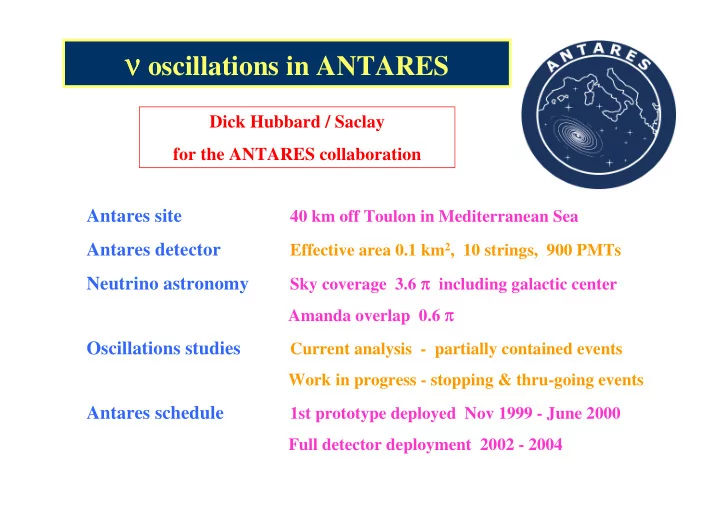

ν oscillations in ANTARES ν Dick Hubbard / Saclay for the ANTARES collaboration time calibration LED beacon Antares site 40 km off Toulon in Mediterranean Sea Antares detector Effective area 0.1 km 2 , 10 strings, 900 PMTs Sky coverage 3.6 π π including galactic center Neutrino astronomy Amanda overlap 0.6 π π Oscillations studies Current analysis - partially contained events Optical modules Work in progress - stopping & thru-going events Antares schedule 1st prototype deployed Nov 1999 - June 2000 Full detector deployment 2002 - 2004
ANTARES collaboration � CPPM, Marseille (IN2P3) � University of Oxford � DSM/DAPNIA, Saclay (CEA) � University of Sheffield � IReS, Strasbourg � Univ. of H.-A., Mulhouse � C.O.M. Marseille � IFREMER, Marseille/Brest � IGRAP (INSU), Provence � ITEP, Moscow � University and INFN, Bari � University and INFN, Bologna � University and INFN, Catania � IFIC, Valencia � INFN - LNS, Catania � University I and INFN, Rome � NIKHEF, Amsterdam � University and INFN, Genova
ANTARES scientific program Low Energy Medium Energy High Energy ν from (extra-) ν ν ν oscillations Neutralino search χ χ → → ν + χ χ ν + X galactic sources Observation of first center of earth, sun, galaxy SN remnants, oscillation minimum AGN, GRB, ... GRB cannonballs
ANTARES detector 0.1 km 2 effective area, 10 strings, 900 PMTs Deployment starts in 2002 shore station time calibration LED beacon 2400 m float electronic container ~60 m electro-optic submarine cable ~ 40 Km ~300 m Optical modules hydrophone Acoustic beacon ~100 m anchor Junction box
Water optical properties Water transparency: - Blue light 470 nm λ abs ~ 55 m λ λ λ scat eff ~ 300 m - UV light 370 nm Optical background: λ abs ~ 25 m λ ~ 60 kHz on 10” PMT mainly 40 K λ λ scat eff ~ 120 m + bioluminescence λ scat λ bursts λ λ scat eff = 1 - < cos θ θ > ⇒ ⇒ < 5% dead time / PMT
Ο Ο scillations analyses Current analysis Contained events and leaving muons 10 string detector : generate ν ’s with E ν = 4 - 300 GeV Atmospheric neutrino flux from Bartol : statistical errors only Large hadronic showers rejected by quality cuts Work in progress Hadronic showers for partially-contained events at 1 σ Shower energy precision ~ factor 2 Minimum error ~ ± 10 GeV ⇒ poor for Super-K parameters Analysis of stopping and through-going muons Generate neutrinos with E ν = 4 GeV - 100 TeV Two analyses using visible E/L or zenith-angle distribution ν flux normalization from data : fitted as 3rd parameter
ν ν oscillations : partially-contained events Bartol atmospheric ν ν flux 4 years, 90% C.L. 720 single-string events 2100 multi-string events Statistical errors only exclusion Oscillations analysis : ratio with and without oscillations E / cos θ E / cos θ E / cos θ
ν ν oscillations : all events Atmospheric ν ν flux = 3rd parameter 90% C.L exclusion after 3 years Zenith angle distribution Multi-string events - no containment cuts E/L distribution - no containment cuts Single- and multi-string events E/L distribution - partially-contained only Single- and multi-string events 4063 events per year including ..294 partially-contained single-string ..428 partially-contained multi-string 3341 thru-going + stopping multi-string Systematic errors ± ± 5% bin-to-bin
Comparative precision 10 -2 Sensitivity for 3 years data Assuming Super-K parameters from Neutrino-2000 conference ∆ m 2 ∆ (eV 2) 90 % C.L. for Antares, Opera and Super-K 68 % C.L. for Minos 10 -3 sin 2 2 θ θ
Sources of systematic errors Background sources Electron- and tau-neutrino backgrounds negligible Atmospheric single- and multi-muon backgrounds small Detector acceptance and calibration Relative timing and relative positions should be O.K. Calibrate efficiencies for single-string and multi-string events ? Atmospheric neutrino flux Flux normalization fit as 3rd parameter in oscillations analysis Flux shape uncertainties influence mainly sin 2 2 θ determination
Conclusions Three low-energy ν ν studies for Antares E ν ν < 1 TeV Neutrino oscillations - guaranteed physics result Dark matter - only if favorable DM parameters Cannonballs - possible early astrophysics result Oscillations parameters : work in progress ∆ m 2 precision improved throughout Super-K allowed region for sin 2 2 θ = 1 exclusion zone covers ∆ m 2 = 3 × 10 -4 - 0.6 eV 2 for ∆ m 2 = 3.5 × 10 -3 eV 2 exclusion zone covers sin 2 2 θ > 0.25 Systematic errors important Flux shape and differential efficiency mainly affect sin 2 2 θ
Recommend
More recommend